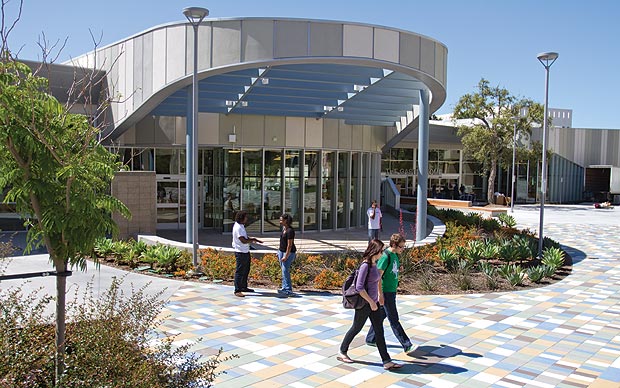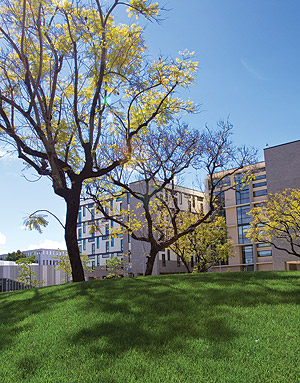
Home Run
New Residences Offer Living-Learning Community
Freshman Carolyn Cordway, a student ambassador who gives tours of Cal State Fullerton’s residence halls, is excited about the enhanced experiences the university’s new complex offers for both residents and non-residents.
With 1,064 new students more than doubling the number now living on campus, the $143-million housing project will prompt a re-envisioning of CSUF’s reputation as a commuter campus, Cordway said.
“The new project will offer a phenomenal experience for the students,” she said. “With the addition of that many more residents, students will be more networked and integrated to the university. There will be more school spirit.”
Underwritten with bond funding, the complex is designed to provide a small-college experience in a large university setting, said Fred Lipscomb, director of housing and residence life.
Although the new residence halls are not officially part of the Titan Pride initiative, they are closely related to the initiative's goals.
“We are building a living-learning community,” Lipscomb said. “Slowly that commuter image will change. There will be a new focus; we’ll be changing the face of Fullerton with increased campus life.”
The living-learning concept, Lipscomb explained, underscores that idea that students are actively engaged in not only academics but in all aspects of campus life. “A true living-learning environment is one that promotes learning outside the classroom,” Lipscomb said. “In student housing, we strive to build a community that supports that concept.”
Like the existing residence halls, the new ones are named after trees – Fig, Pine, Holly, Juniper and Elm. They feature two faculty-in-residence apartments, two additional residential community coordinator apartments, a convenience market, study and recreation rooms on each floor, and conference rooms.
With occupation scheduled in time for the fall semester, the new residence halls will house freshmen, with other classes housed in the original residence halls. The new project is expected to earn LEED gold certification by the U.S. Green Building Council for its sustainable design, construction and operation.
Existing student housing consists of apartment-style living, with residents responsible for the upkeep of their apartments. New student housing consists of five dormitory-style buildings, with living spaces for two students per room and a common public bathroom. Staff will provide housekeeping services for the public bathrooms and common areas.
The 585-seat Gastronome dining facility, with ARAMARK providing food service, features indoor and outdoor seating and a fire pit. It will have a wood-burning oven and buffet-style service, and several big-screen TVs are located throughout. Continuous dining plans mean students can eat as little or as much as they want virtually any time of day, Lipscomb said. Late-night dining will be open until 1 or 2 a.m.
With nearly 2,000 students living on campus, seven days a week, 24 hours a day, nighttime activity will reach a new level as students look for outlets outside the classroom, Lipscomb said.
“We will see a more vibrant campus life,” agreed Kandy Mink Salas, associate vice president for student affairs. “Because more students will be here, they will ask more from us. There will be more face time with faculty, and students will be more available for creative and research activities. I believe we will see more students attending campus events, such as art shows and lectures, and I think we will see an increase in the number of students participating in on-campus leadership positions.”
Because alumni recall fondly what goes on outside the classroom, residence life is an important component of higher education, noted Silas Abrego, acting vice president for student affairs.
“Whether it’s meeting new people, attending cultural or athletic events, or participating in clubs – these are the places where students make lifelong friends,” Abrego said. “The campus will be alive all the time as our students build strong networks of friends and peers.” ![]()


